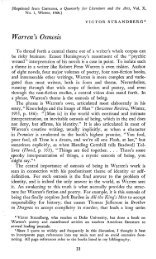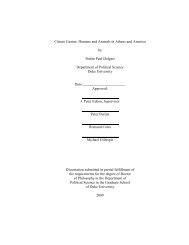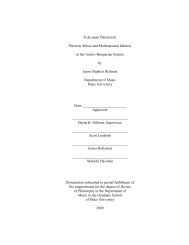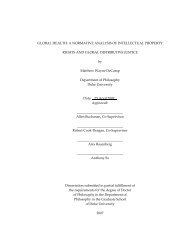View/Open - DukeSpace - Duke University
View/Open - DukeSpace - Duke University
View/Open - DukeSpace - Duke University
Create successful ePaper yourself
Turn your PDF publications into a flip-book with our unique Google optimized e-Paper software.
such, the Comrade stories that appeared during this period, including “The Illusive Mind,”<br />
address issues concerning freedom of expression in relation to modern China’s socialist market<br />
economy.<br />
Concurrently, great strides were made in the Chinese literary realm, partly due to<br />
influences from Western discursive practices but also as a result of localized literary<br />
developments in the 1980s. With the end of the Cultural Revolution, literary ideals that had long<br />
been oppressed became active (Zhang and Ming 2007). 27 Chinese writers began to embrace<br />
contemporary discursive practices such as post-modernism, reflexivity, and self-consciousness in<br />
writing. As Comrade authors gained exposure to different literary works and the Chinese online<br />
tongzhi culture, both new but rapidly changing phenomena, the stories produced mirror the<br />
growing self-awareness among Chinese gays (Simon 2001). The earliest stories (with “Beijing<br />
Story” as the foundational novella) served as a refuge from reality, whereas later works reflect<br />
less need for these types of texts (Cristini 2005). Increasingly, authors of Comrade stories could<br />
not just rely on explicit homosexual content to engage and impress their readership, and<br />
developed their literary writing skills. This is evident in the greater thematic diversity<br />
distinguished by inventive plots and poetic language of stories published at the turn of the<br />
twenty-first century.<br />
Even though almost two decades have passed since “Beijing Story” (1996) was first<br />
circulated, few Comrade texts from the Mainland have garnered the same level of attention and<br />
27 Scholars have highlighted that, immediately following the end of the Cultural Revolution, political objectives<br />
came first and artistic aims second, and works prioritized commenting on or documenting past history to “make up”<br />
for the ten-year absence of literary production (Wang and Lin 2011). In contrast, when China experienced rapid<br />
development that transformed the nation’s social, political, and economic landscape, an exclusive concentration<br />
articulating political objectives was abandoned and “the understanding of ‘art’ and ‘literature’ became the new<br />
criterion of concealment and revelation” (Wang and Lin 2011, 237). With the intensification of market reforms,<br />
Chinese literature and culture turned increasingly commercial and escapist, and writers increasingly recognized the<br />
role of literature in exposing social problems and activating future social change (Woesler 2008). In the age of<br />
globalization, new categories of writing that highlight the impact of modernization and consumerism in China’s<br />
sociopolitical environment began to develop on the Chinese literary front. In general, new Chinese writings across<br />
all genres exhibit an increase in conscious attention to aesthetic detail and artistic style (Woesler 2008). Texts that<br />
were produced under the genre of Comrade Literature also bear the mark of this progression.<br />
Chapter One | 44
















